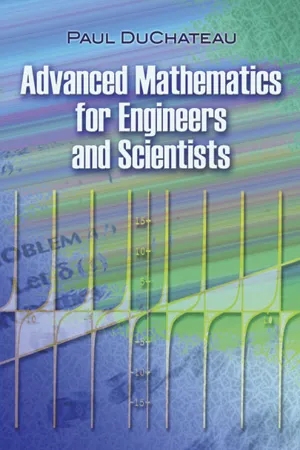
This is a test
- 400 pages
- English
- ePUB (mobile friendly)
- Available on iOS & Android
eBook - ePub
Advanced Mathematics for Engineers and Scientists
Book details
Book preview
Table of contents
Citations
About This Book
This book can be used as either a primary text or a supplemental reference for courses in applied mathematics. Its core chapters are devoted to linear algebra, calculus, and ordinary differential equations. Additional topics include partial differential equations and approximation methods.
Each chapter features an ample selection of solved problems. These problems were chosen to illustrate not only how to solve various algebraic and differential equations but also how to interpret the solutions in order to gain insight into the behavior of the system modeled by the equation. In addition to the worked-out problems, numerous examples and exercises appear throughout the text.
Each chapter features an ample selection of solved problems. These problems were chosen to illustrate not only how to solve various algebraic and differential equations but also how to interpret the solutions in order to gain insight into the behavior of the system modeled by the equation. In addition to the worked-out problems, numerous examples and exercises appear throughout the text.
Frequently asked questions
At the moment all of our mobile-responsive ePub books are available to download via the app. Most of our PDFs are also available to download and we're working on making the final remaining ones downloadable now. Learn more here.
Both plans give you full access to the library and all of Perlego’s features. The only differences are the price and subscription period: With the annual plan you’ll save around 30% compared to 12 months on the monthly plan.
We are an online textbook subscription service, where you can get access to an entire online library for less than the price of a single book per month. With over 1 million books across 1000+ topics, we’ve got you covered! Learn more here.
Look out for the read-aloud symbol on your next book to see if you can listen to it. The read-aloud tool reads text aloud for you, highlighting the text as it is being read. You can pause it, speed it up and slow it down. Learn more here.
Yes, you can access Advanced Mathematics for Engineers and Scientists by Paul DuChateau in PDF and/or ePUB format, as well as other popular books in Mathematics & Applied Mathematics. We have over one million books available in our catalogue for you to explore.
Information
1
Systems of Linear Algebraic Equations
This chapter provides an introduction to the solution of systems of linear algebraic equations. After a brief discussion of matrix notation we present the Gaussian elimination algorithm for solving linear systems. We also show how the algorithm can be extended slightly to provide the so-called LU factorization of the coefficient matrix. This factorization is nearly equivalent to computing the matrix inverse and is an extremely effective solution approach for certain kinds of problems. The solved problems provide simple BASIC computer programs for both the Gaussian elimination algorithm and the LU decomposition. These are applied to example problems to illustrate their use. The solved problems also include examples of physical problems for which the mathematical models lead to systems of linear equations.
The presentation of the solution algorithms is rather formal, particularly with respect to explaining what happens when the algorithms fail in the case of a singular system of equations. To provide a clearer understanding of these and other matters we include a brief development of some abstract ideas from linear algebra. We introduce the four fundamental subspaces associated with a matrix A: the row and column spaces, the null space and the range of A. The relationships that exist between these subspaces and the corresponding subspaces for the transpose matrix AT provide the key to understanding the solution of systems of linear equations in the singular as well as the nonsingular case. The solved problems expand on the ideas set forth in the text. For example, Problem 1.15 gives a physical interpretation for the abstract solvability condition that must be imposed on the data vector in a singular system. Problems 1.16 through 1.20 discuss the notion of a “least squares” solution for an overdetermined system and apply this to least squares fits for experimental data.
We should perhaps conclude this introduction with the disclaimer that this chapter is meant to be only an introduction to the numerical and abstract aspects of systems of linear algebraic equations. While the Gaussian elimination algorithm does form the core of many of the more sophisticated solution algorithms for linear systems, the version provided here contains none of the enhancements that ex...
Table of contents
- DOVER BOOKS ON MATHEMATICS
- Title Page
- Dedication
- Copyright Page
- Table of Contents
- Preface
- 1 - Systems of Linear Algebraic Equations
- 2 - Algebraic Eigenvalue Problems
- 3 - Multivariable Calculus
- 4 - Ordinary Differential Equations: Linear Initial Value Problems
- 5 - Nonlinear Ordinary Differential Equations
- 6 - Linear Boundary Value Problems
- 7 - Fourier Series and Eigenfunction Expansions
- 8 - Integral Transforms
- 9 - Linear Problems in Partial Differential Equations
- 10 - Linear and Nonlinear Partial Differential Equations
- 11 - Functional Optimization and Variational Methods
- 12 - Finite Difference Methods for Differential Equations
- 13 - Introduction to the Finite Element Method
- Index